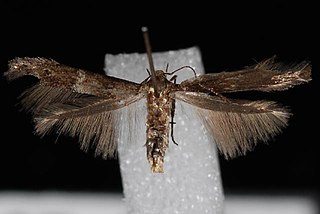Related Research Articles

The Batrachedridae are a small family of tiny moths. These are small, slender moths which rest with their wings wrapped tightly around their bodies.
Sorhagenia is a genus of moths in the family Cosmopterigidae. The name honours Ludwig Friedrich Sorhagen.
Periploca fessa is a moth in the family Cosmopterigidae. It was described by Ronald W. Hodges in 1962. It is found in North America, where it has been recorded from Florida, Louisiana, Arkansas, Texas and Wyoming.
Periploca serrulata is a moth in the family Cosmopterigidae. It was described by Ronald W. Hodges in 1978. It is found in North America, where it has been recorded from Utah.
Periploca tridens is a moth in the family Cosmopterigidae. It was described by Ronald W. Hodges in 1978. It is found in North America, where it has been recorded from California.
Sorhagenia baucidis is a moth in the family Cosmopterigidae. It was described by Ronald W. Hodges in 1969. It is found in North America, where it has been recorded from Illinois and Saskatchewan.
Sorhagenia cracens is a moth in the family Cosmopterigidae. It was described by Ronald W. Hodges in 1978. It is found in North America, where it has been recorded from Idaho.

Sorhagenia nimbosus, the midrib gall moth, is a moth in the family Cosmopterigidae. It was described by Annette Frances Braun in 1915. It is found in North America, where it has been recorded from British Columbia, Washington and California.
Sorhagenia pexa is a moth in the family Cosmopterigidae. It was described by Ronald W. Hodges in 1969. It is found in North America, where it has been recorded from Texas, Arkansas and Illinois.
Stilbosis dulcedo is a moth in the family Cosmopterigidae. It was described by Ronald W. Hodges in 1964. It is found in North America, where it has been recorded from California and Arizona.
Stilbosis juvantis is a moth in the family Cosmopterigidae. It was described by Ronald W. Hodges in 1964. It is found in North America, where it has been recorded from Arizona.
Stilbosis nubila is a moth in the family Cosmopterigidae. It was described by Ronald W. Hodges in 1964. It is found in North America, where it has been recorded from Utah to Arizona and New Mexico.
Stilbosis rhynchosiae is a moth in the family Cosmopterigidae. It was described by Ronald W. Hodges in 1964. It is found in North America, where it has been recorded from Tennessee.
Stilbosis risor is a moth in the family Cosmopterigidae. It was described by Ronald W. Hodges in 1964. It is found in North America, where it has been recorded from Arizona.
Stilbosis sagana is a moth in the family Cosmopterigidae. It was described by Ronald W. Hodges in 1964. It is found in North America, where it has been recorded from Arizona.
Stilbosis stipator is a moth in the family Cosmopterigidae. It was described by Ronald W. Hodges in 1964. It is found in North America, where it has been recorded from Arizona.
Stilbosis venatrix is a moth in the family Cosmopterigidae. It was described by Ronald W. Hodges in 1964. It is found in North America, where it has been recorded from Arizona.
Stilbosis venifica is a moth in the family Cosmopterigidae. It was described by Ronald W. Hodges in 1964. It is found in North America, where it has been recorded from Maryland, Arkansas, West Virginia and Illinois.
Stilbosis victor is a moth in the family Cosmopterigidae. It was described by Ronald W. Hodges in 1964. It is found in North America, where it has been recorded from Illinois, Indiana, Ohio, New Jersey, Virginia and Arkansas.
Stilbosis scleroma is a moth in the family Cosmopterigidae. It was described by Ronald W. Hodges in 1978. It is found in North America, where it has been recorded from Arizona.
References
- ↑ Savela, Markku. "Sorhagenia daedala Hodges, 1964". Lepidoptera and Some Other Life Forms. Retrieved January 18, 2019.
- ↑ "420341.00 – 1635 – Sorhagenia daedala – Hodges, 1964". North American Moth Photographers Group. Mississippi State University. Retrieved January 18, 2019.
- Pitkin, Brian & Jenkins, Paul. "Search results Family: Arctiidae". Butterflies and Moths of the World. Natural History Museum, London.
| This article relating to Chrysopeleiinae is a stub. You can help Wikipedia by expanding it. |